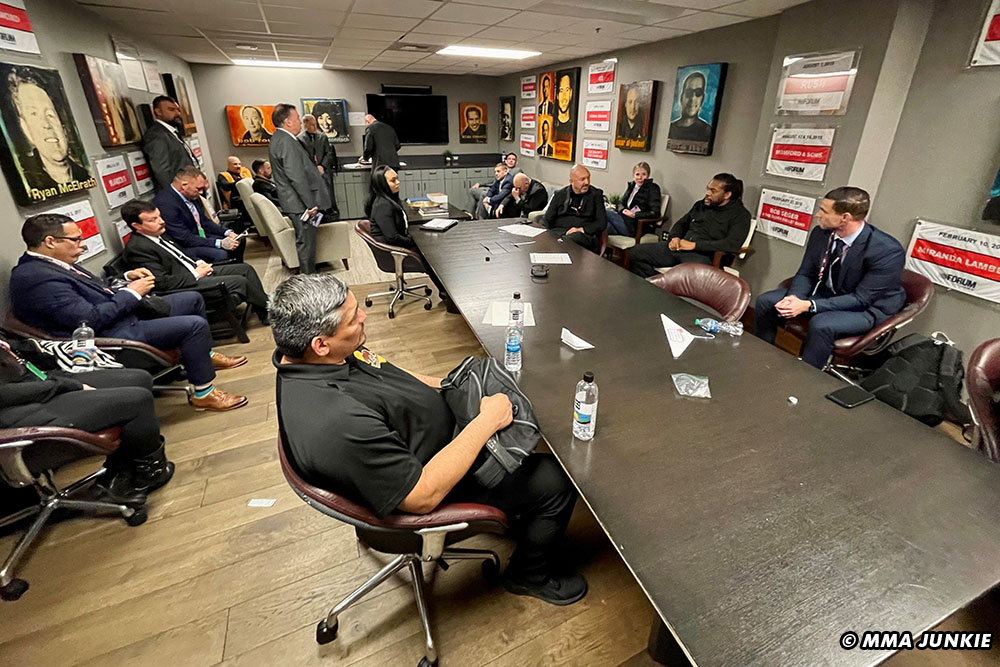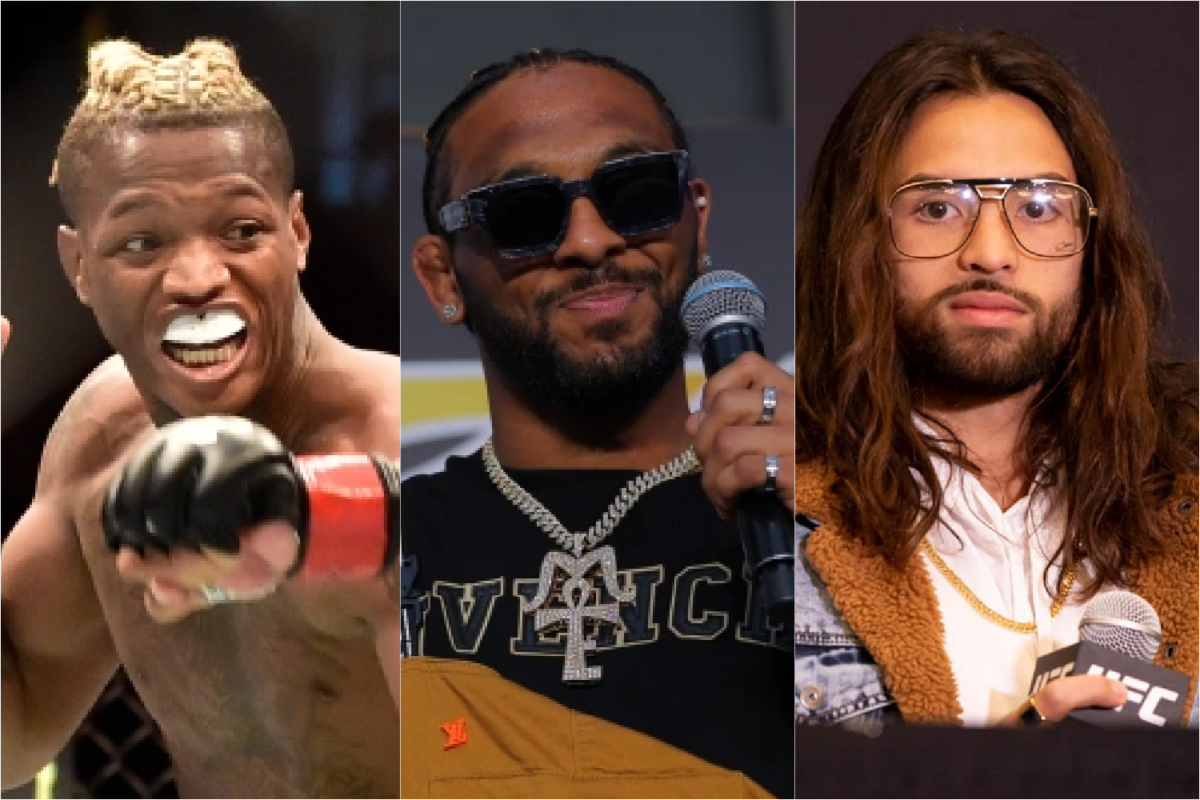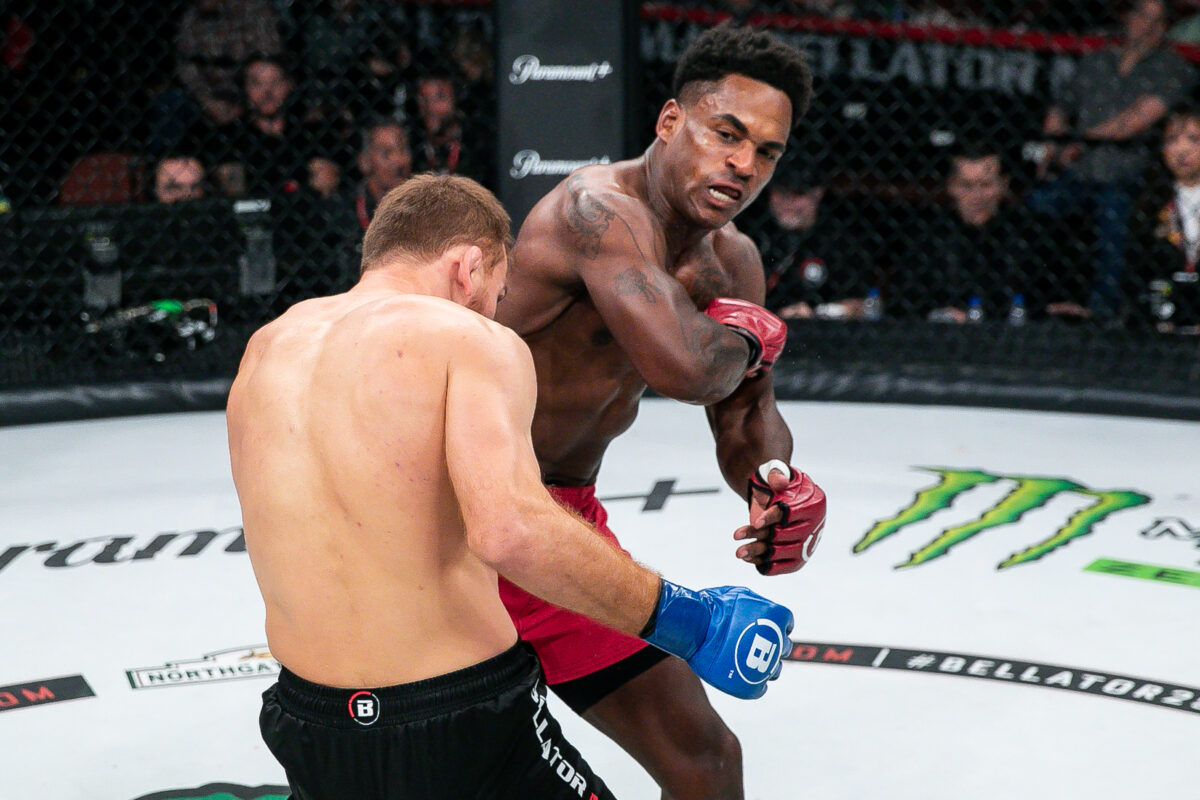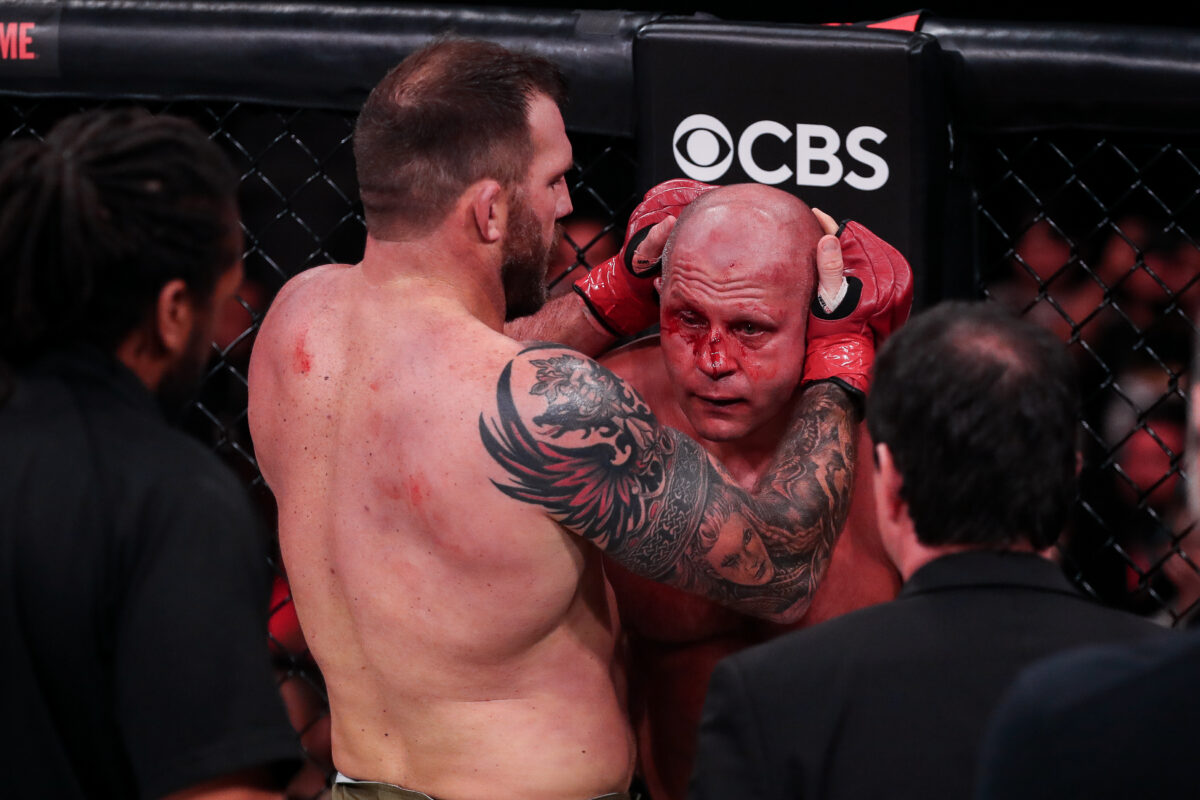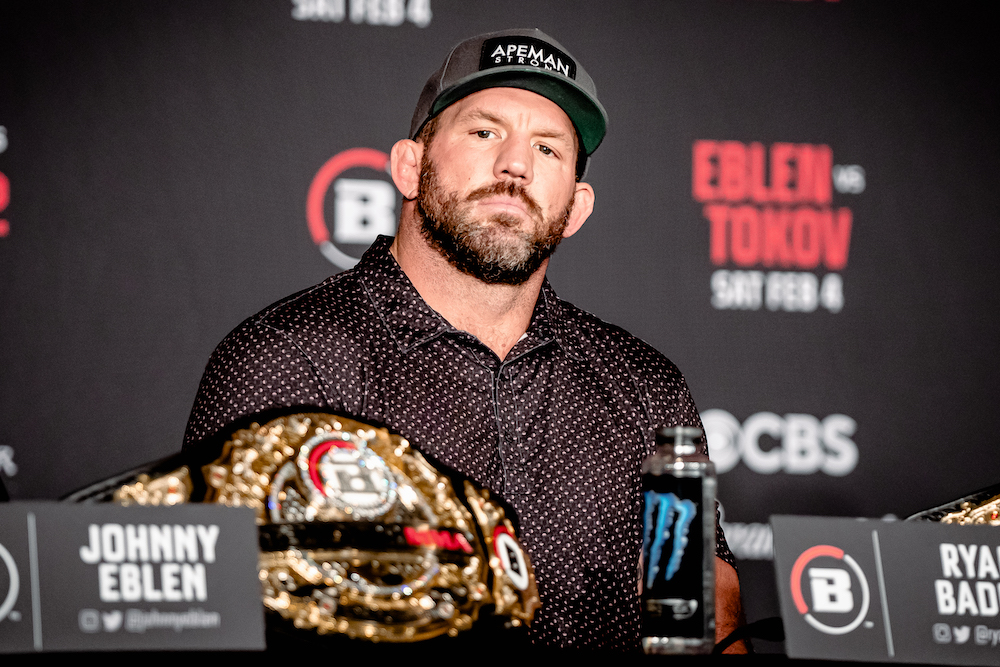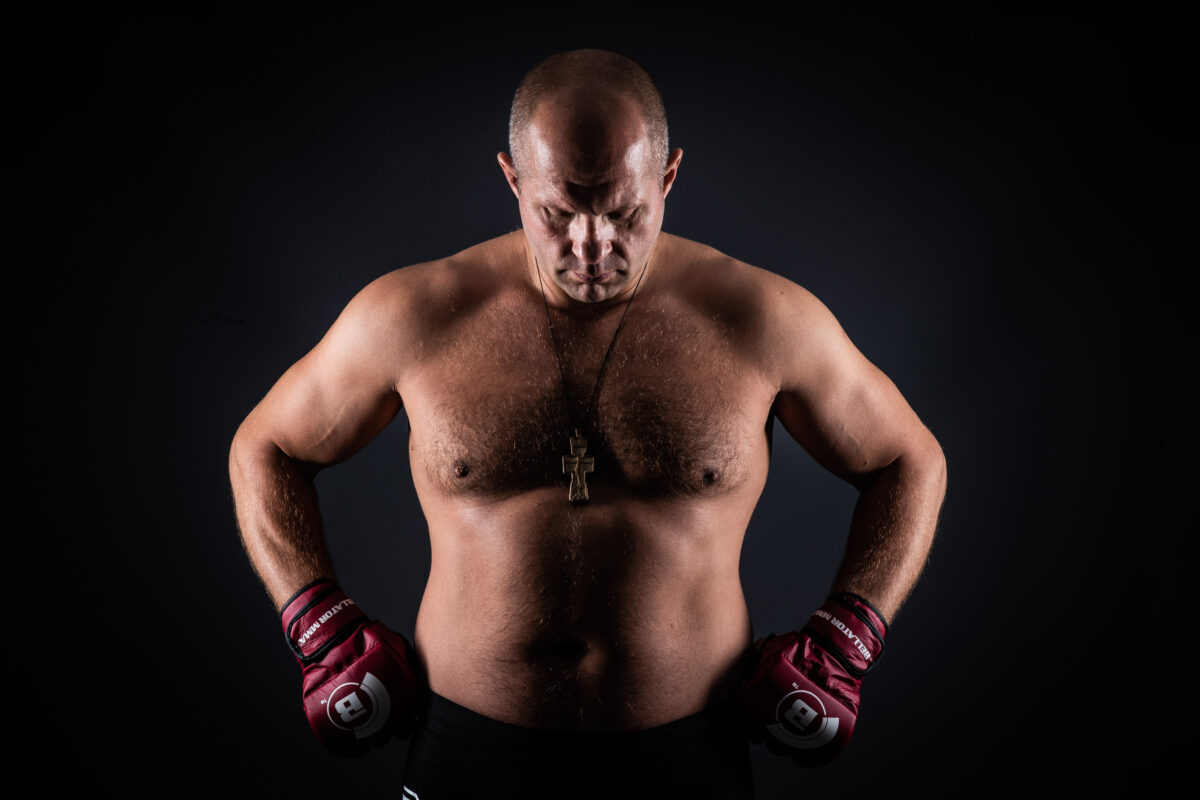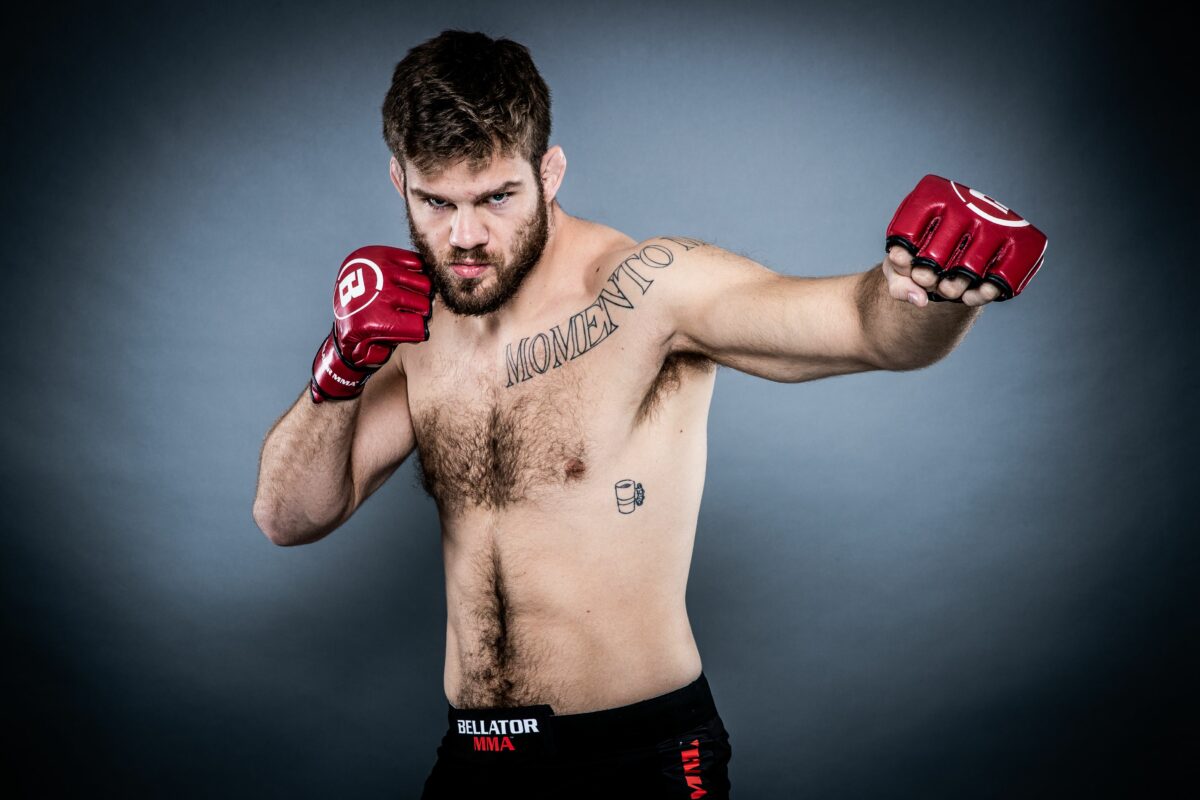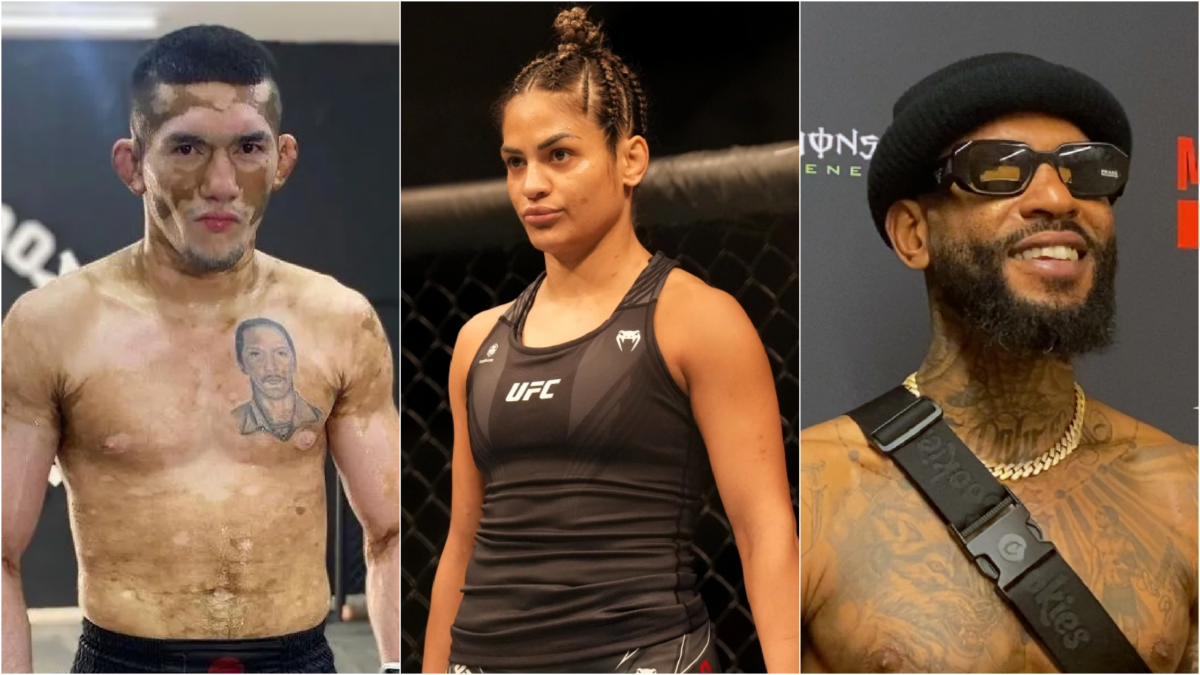Calls for transparency and accountability from judges is a constant thing in MMA. After all, it’s a big responsibility given the livelihoods of fighters depend on judges “getting it right.” And yet, state athletic commissions who hire these officials never make them available to the media – until now.
At Bellator 290 on Feb. 4, the California State Athletic Commission allowed MMA Junkie to attend its immediate post-event debriefing, where judges and referees discussed their decisions with CSAC executives. It was the first time a news organization has been granted access to such a meeting after a major MMA event. Below is an in-depth recap.
*****
Two days after [autotag]Kai Kara-France[/autotag] lost to [autotag]Amir Albazi[/autotag] in the UFC on ESPN 46 main event, popular combat sports personality Ariel Helwani was flabbergasted by the outcome.
Just how egregious was it? Nineteen of 21 media members scored the fight for Kara-France, according to MMADecisions.com, making it one of the most disputed fights of the year.
Helwani, host of “The MMA Hour,” went on his June 5 show echoing the sentiment of just about everyone who watched the fight. He lambasted both judges – Chris Lee and Sal D’Amato – responsible for awarding Albazi a split decision with 48-47 scores. Mike Bell was the dissenting judge who went 48-47 for Kara-France.
The result, or what some might call a “robbery,” had Helwani wondering what could change – nothing radical, but something feasible.
“One thing that I think is changeable, if that’s even a word … is transparency and accountability,” Helwani said. “And what I mean by that is, why is it that we do not hear from these men and women who are the officials on Saturday night, on Sunday, on Monday to at least explain to us what they were thinking?”
The simple answer is that athletic commissions, who hire and assign MMA judges and referees, widely discourage them from openly discussing the fights they officiate. The Nevada Athletic Commission, which oversaw Albazi vs. Kara-France at the UFC Apex in Las Vegas, long has frowned upon judges speaking to the media, with one judge telling MMA Junkie that message has been communicated from NAC executives in the past.
The California State Athletic Commission, however, believes in doing things differently. Helwani said he found this out when he made a phone call to CSAC executive director Andy Foster after the UFC on ESPN 46 main event controversy.

“Andy Foster, he told me, believe it or not, after every event in California – I’ve been doing this since 2006, (and) I never knew this,” Helwani said. “After every event in California, there is actually a commission meeting with the officials that the media is allowed to attend. Did you guys know this? I never knew this.”
It’s true.
In fact, four months prior to UFC on ESPN 46, during a phone conversation in the lead up to Bellator 290 on Feb. 4, Foster invited me to the CSAC’s debriefing for the event held at The Forum in Inglewood. Much to my surprise, I didn’t have to ask. He invited me.
“There’s this nonsense going around in various media circles that commissions are not transparent,” Foster told me. “Nobody’s ever asked to come. You’re welcome to come anytime you want to.”
So I took him up on the offer. Roughly 15 minutes after the final fight at Bellator 290, I sat in an arena conference room while Foster led the meeting of CSAC executives, inspectors, judges, and referees who powwowed about what transpired.
From where I sat cageside, three fights were particularly of interest for different reasons: [autotag]Darrion Caldwell[/autotag] vs. [autotag]Nikita Mikhailov[/autotag]; [autotag]Diana Avsaragova[/autotag] vs. [autotag]Alejandra Lara[/autotag]; and [autotag]Ali Isaev[/autotag] vs. [autotag]Steve Mowry[/autotag].
And so, I went into the CSAC meeting with questions about all three. It was an enlightening first-time experience to hear judges and one prominent referee speak for themselves to this extent immediately after the fights.
‘It’s rare to see a fighter win off his back’

Result: Nikita Mikhailov def. Darrion Caldwell via unanimous decision (29-28, 29-28, 29-28)
Judges: Chris Leben, Jon Marigliano, Felicia Oh; all three scored each round exactly the same.
Media scores: Four out of five 29-28 in favor of Caldwell (via MMADecisions.com)
Referee: Raphael Davis
Synopsis: This fight came down to the second round. Within the first minute, Caldwell secured a takedown, took Mikhailov’s back and worked a rear-naked choke that, for a moment, was locked in tightly. Mikhailov fought off the hands and then his defense, while lying supine on top of Caldwell, was to throw short, backward punches over his shoulder that landed. With about three minutes remaining, Mikhailov tried to escape by rolling into Caldwell, who did a nice job staying on top but in Mikhailov’s guard. With his back on the mat, Mikhailov kept busy with elbows. Despite owning top control, Caldwell didn’t take full advantage. At the 1:10 mark, referee Davis stood them up. Caldwell landed a nice counter left and hit a perfectly timed double leg takedown to end up inside of Mikhailov’s guard with about 50 seconds remaining. Caldwell was more active with his attach to close the round, but Mikhailov also went back to throwing elbows.
MMA Junkie asks: Caldwell spent the majority of Rounds 1 and 2 in top control and seemed to have secured both of them. Why did all three judges score Round 2 in favor of Mikhailov?
Foster: “He got a takedown, and he had a choke. It’s unusual that you see the amount of damage that that fighter that was being choked or was in that position come back, so I’ve got to think that’s probably what the judges were seeing because they all came back with the same score. The elbows were pretty hard. Chris, you want to start?”
Leben: “It’s rare to see a fighter win off his back, but his striking was far more effective off his back than the grappling was on top. It’s as simple as that. The striking was the most effective thing in that round.”
Marigliano: “Yeah, I agree with that. Initially he had him in the rear and had a choke attempt, but after that dissipated, Caldwell was on top and didn’t, in my eyes, come close to any valid submission, and the guy on the bottom was just damaging with elbows. Really from the three-minute, four-minute, five-minute (marks), all the strikes were landed by the guy on the bottom in my humble opinion.”
Oh: “He had the top position, but he didn’t really do anything. There was a lot of holding. At the beginning, he was attempting the choke. But even after that, he was taking punches, and he wasn’t really trying to finish it. He was more holding. The elbows from the bottom were definitely much more effective.”
Foster: “There was the attempt there where I think he was really trying to get the choke for a little while, for a short amount of time. And it’s like he was content to just sit there and get hit because he was in the better position, but we’re not playing the grappling match. I’m not saying you’ve got to agree with the judges, but you’ve heard their explanation.”
Odd judge explains his thinking

Result: Diana Avsaragova def. Alejandra Lara via split decision (29-28, 28-29, 29-28)
Judges: Hadi Mohamed Ali, Raphael Davis, Jon Marigliano; Marigliano was the odd judge who scored it for Lara.
Media scores: Five out of seven 29-28 in favor of Lara (via MMADecisions.com)
Referee: Jonathan Romero
Synopsis: In Round 1, the timing and distance of Avsaragova’s counter striking was the difference, which showed in all three judges’ 10-9 scores in her favor. Round 2 proved to be the difference. Both landed decent strikes through two minutes, close to even, but after that things got interesting. For about the next two minutes, it appeared Avsaragova got the better of the exchanges – if only slightly. Every time Lara closed the distance, Avsaragova faded the combo attacks and landed counters. But in the final 45 seconds, Lara decided to bite down on her mouthpiece and charge forward with looping punches. The combinations were wild, but some of these shots – perhaps the biggest of the round – landed cleanly and caused Avsaragova to retreat. Lara would later tell MMA Junkie’s Danny Segura that she believed she did enough to get the win.
MMA Junkie asks: Overall this was a very close fight that could’ve gone either way. What was the difference for the judge who scored it for Lara?
Marigliano: “I had Lara winning (Round 2). I thought objectively you could see the damage with her rights because the whole left side of Diana, all around her eye, was bruised up to her cheek. Lara had some great leg kicks in the first round and was bruising the inside of the leg. Diana kept coming forward, so I gave (Diana) the first round. The second round, (Lara) was landing those kicks. Now Diana wasn’t coming forward, so subjectively I thought she had diminished energy. She wasn’t active coming forward, and Lara kept coming forward and was hurting her with the leg kicks. But I really thought she had some right power punches that were more effective the second round and incurred a good bit of damage. That’s why I gave it to her. I thought her striking was more effective – maybe not more efficient, but more effective.”
Foster: “My notes on Round 2 was, ‘Very close, both had moments, that round could’ve gone either way.’ That’s literally what I thought.”
‘I was definitely close to stopping it’

Result: Ali Isaev vs. Steve Mowry declared unanimous draw (28-28, 28-28, 28-28)
Judges: Hadi Mohamed Ali, Chris Crail, Elliot Kelly; all three scored each round exactly the same.
Media scores: Eight out of nine 28-28 draw (via MMADecisions.com)
Referee: Herb Dean
Synopsis: There was a pivotal moment within the first 30 seconds of Round 2 when Isaev tried to throw Mowry to the ground, but he missed it and ended up with Mowry on his back, which quickly escalated once Mowry locked in hooks and flattened Isaev on his belly. With his legs hovering above the canvas, Isaev had no escape. For the next 30 seconds, Isaev absorbed a plethora of punches as he struggled to defend himself. During the barrage, referee Dean could be heard on the broadcast telling Isaev to “fight back” and “get out of there” several times as he warned of an impending stoppage. Ultimately, Dean didn’t stop the fight in that moment. The round continued with Mowry in firm control, going back and forth between ground-and-pound and arm-triangle choke attempts while an exhausted Isaev could do nothing but lay there and defend. It was a clear 10-8 for Mowry from all three judges, which led to the unanimous draw.
MMA Junkie asks: There was good reason to stop the fight in Round 2 when Mowry was on Isaev’s back, flattened him out and rained ground-and-pound down on him. The crowd seemed to be calling for a stoppage. Herb, what did you see, and why did you let the action continue?
Dean: “I was close to stopping the fight. I go into the fighters’ rooms, and I give instructions before the fight. I talk about some of the fouls and things like that, but I always tell them, ‘The most important thing I’m going to tell you is before I intervene, I’m going to talk to you. If I say fight back, that means I’m about to stop your fight. What I expect from you is I want to see an effort that lets me know you know what’s going on, you still want to do this, and some sort of effort to solve your position.’ So if I see someone getting pounded on and I say fight back, and he just lays there and continues to (cover up) and hopefully it goes away, then I’m going to stop that fight. But if someone gives me effort to make their position better – now, they don’t always have to be successful, but their effort has to be something where maybe it’s going to make it harder for the other person, he breaks his posture or he has to stop punching. And that’s what that young man (Isaev) did. Whenever I told him to fight back, he gave an effort to get out of the position. He wasn’t successful getting out of the position, but he gave effort, and the other guy had to keep addressing it. Then, after he stopped, I always have to balance if the guy is able to defend himself and how much is he defending himself from. When it got to about the last minute-and-a-half of the round, (Mowry) was still in the mount and about to come after him again, but this time the guy on top was diminished from maintaining that position and trying to (finish the fight). Earlier he was able to roll elbows and land them; this time when he tried to roll elbows or set stuff up, he was never able to land something. So for the last minute of the round, even though (Mowry) was coming after him, he never really landed anything that effective. So (Isaev) did enough to make it through the round. I was definitely close to stopping it, though.”
Final takeaway
Bellator 290 didn’t provide us with a robbery or controversy on the level of Albazi vs. Kara-France, or Alexa Grasso vs. Valentina Shevchenko at Noche UFC, or Paddy Pimblett vs. Jared Gordon at UFC 282, or Sean O’Malley vs. Petr Yan at UFC 280, or any number of high-profile decisions that have made observers scratch their heads. But the event did have a fair number of questions given the 14-fight lineup, and it was insightful to be in that room.
When Bellator returns to the “Golden State” for Bellator 300 on Friday in San Diego, the CSAC will gather immediately afterward to review the event. Reporters are welcome to attend. With four title fights on the night, the judges are sure to be under the spotlight.
But this is what transparency looks like in MMA officiating. There’s too much at stake to not hold judges accountable for their decisions.
The CSAC gets that and is to be commended for going against the grain on this issue. Hopefully more commissions are willing to follow Foster’s lead.
For more on the card, visit MMA Junkie’s event hub for Bellator 290.
